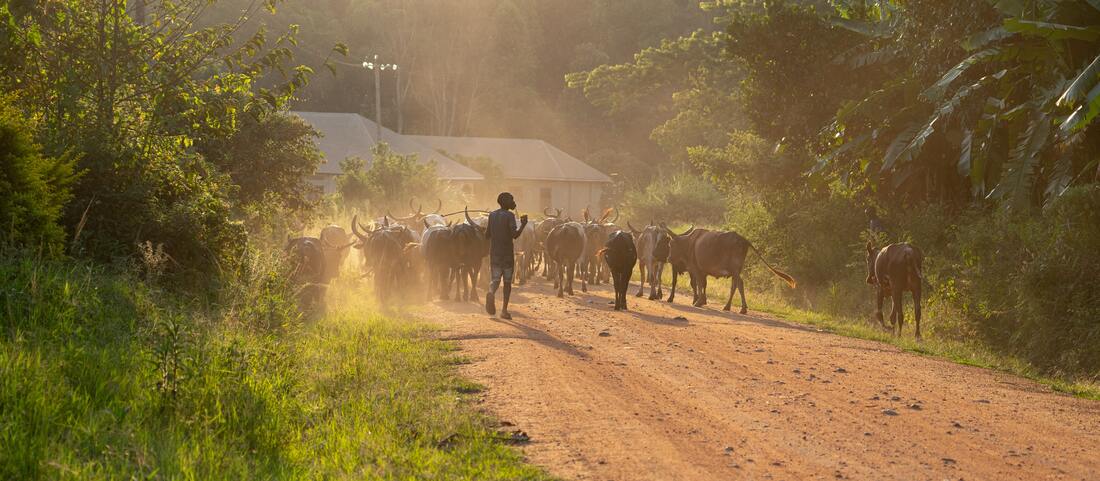Internal Displacement and Land Disputes: How the Aftermath of War Still Affects Northern Uganda11/2/2022 When the Lord’s Resistance Army and the Ugandan government agreed to a ceasefire in 2006, the lives and customs of Northern Ugandans were already uprooted. In addition to the many thousands murdered, kidnapped and otherwise hurt in the conflict, large parts of the population were forcefully displaced from their homes. According to one estimate, 1.8 million Ugandans left their homes in search of refuge from the conflict between the Lord’s Resistance Army and the Uganda People’s Defense Force (Mukwana&Ridderbos, 2008). Many of the displaced were moved to so-called protected villages; huge refugee camps, often miles away from the homes of the displaced. In the aftermath of the conflict, the government has initiated different programs aiming to resettle and reintegrate the displaced. However, land conflict continues to pose a threat to economic development and peacekeeping efforts in the region. Due to intense fighting between the Lord’s Resistance Army and the Uganda People’s Defense Force, many Ugandans had to abandon their homes. Some escaped because of immediate danger, however many were moved to camps by the government. The displacement camps aimed to protect civilians from the rebels, but also to harm the rebels’ conduct. By limiting agricultural production to areas within or close to the camps, the Uganda People’s Defense Force restricted the rebels’ access to food. They also limited their sphere of influence, by physically restricting access to the people. Many suffered poor living standards in the camps. In addition to limited freedom and lack of access to their homes and farms, the displaced peoples have been removed from the social institutions of their local communities, often lacking access to sufficient health care and education. Sanitation has in many places been poor, and gender and sexual violence has been prevalent. The people of Northern Uganda, where up to 90% of the population was displaced during the conflict, have been particularly affected by these conditions (Miller, 2006). Adding on to the struggles experienced in the displacement camps, many suffered losses as they returned to their places of origins and found their homes occupied by others. When in displacement camps, many people did not visit their homes for years. When the process of resettlement began, the areas had therefore undergone changes, both demographic and geographical. Due to the longevity and complexity of the conflict, some people had started the process of returning to society before others. While some early resettlers returned to their places of origin, others chose to integrate in the area they had been displaced, often on the land of other displaced persons. When later waves of resettlement occurred, the late resettlers could find people living in their houses and cultivating their land. Disputes over such situations have been particularly complex, as it could be argued that both parties have a legitimate claim on the land. The first resettlers, having cultivated the land for up to many years, and often without knowledge that the original owners are alive, do not want to give it up. The other party, on the other hand, has not only historical ties, but also a legal claim to the land. Conflicts like this are further aggravated by the customary nature of Ugandan land ownership. In the customary system, boundaries are not defined by legal contracts, but rather by social agreements and custom. The customary system is at risk during displacement and war, for two main reasons. First, because the agreements are not written down, they are dependent on the consensus and memory of people. During years in camps, many elders passed away, and were therefore not able to pass information on the boundaries of their family homes on to younger generations. This break of knowledge signified a loss of heritage that extended outside the realms of land ownership. Knowledge on culture and customs are often closely tied to the local communities in which people live. As young people were separated, not only from the wider communities, but also from their relatives with knowledge of it, many faced a loss of identity. Losing one's home further intensified this loss in identity, as routines and traditions waned. Another potential risk with the customary system, is that boundaries are defined by local landmarks, rather than maps or other legal documents. During the war, much of Uganda’s rich natural landscape was damaged. With landmarks, woods, paths or rivers ruined, people struggle to recognize the borders of their homes. The changes in territory combined with fewer people knowing the boundaries has exacerbated the process of resettlement, rendering it even more difficult to rebuild communities following the war. When asked about the issue of post-conflict displacement and land issues in Uganda, Mr Ivan Kenneth Ocen, the executive director of Foundation for International Development and Relief Africa (FIDRA), is quick to emphasize the importance of land. “Land ownership translates to a secure place to live,” he says. “It is where people live, it is where society depends, it is where people call a home - it is where people have their entire life. Most of our livelihood depends on land.” This quote echoes what scholars, international institutions and civilians continue to stress: the value of land and land rights in economic development. Stable land ownership is not only beneficial for agricultural production, it has positive effects outside the economic sphere too. Uncertainty and disputes over land tenure hinders peaceful and prosperous recreation of war-affected societies, sometimes even leading to violent confrontation. According to the Internal Displacement Monitoring Centre, one of the largest sources of violence in Northern Uganda is disputes over land ownership. Improving land rights should therefore not only be considered an economic measure, but a central tool in post-conflict peacekeeping.
Securing a safe resettlement for the many displaced has been a central post-conflict goal for the Ugandan government. In 2004, they released the National Policy for Internally Displaced Persons. It was the first of its kind in Africa, and was widely considered to be progressive. Its aim was threefold: to prevent displacement, to protect those who are displaced, and to help displaced people resettle. By promoting human rights in internal displacement camps, the government wanted to relieve the harsh conditions many people have experienced in the camps. For those that already have been displaced, the government aims to enable either return to former homes, resettlement in new areas, or integration to the areas the people currently are in. Today the policy is being criticized, not for its content, but for its implementation. According to Mr Ocen, the issue at hand is not the law, but the allocation of resources, as well as poor implementation of land related acts and laws by the Ugandan Government and its agencies. While the policies are good, there is not allocated enough money to the right institutions for them to be practiced successfully. From his work with the Ugandan civil society, Mr Ocen identifies three groups that are particularly affected by land conflicts and grabbing. First are women, whose legal claim to land inherited from parents or husbands often is neglected or forcefully opposed from others with interest in the land. Second is children, particularly orphans, who may lack knowledge of the boundaries of their parents, and therefore struggle to claim ownership of the land they should have inherited. Third is the poor, who lack the funding to protect their own land. Lack of means poses a bifurcated risk: first, the poor are more at risk of land grabbing, as they are unable to pay for fences or other measures to mark their land. Second, it hinders their ability to reclaim their land once stolen, as many are unable to afford the costs of taking the case to court. Many of the insecurities mentioned here are directly linked to the customary nature of Ugandan land tenure. This is why Mr Ocen strongly advocates a more formalized approach to land ownership, including increased documentation as well as higher awareness of legal rights. He and FIDRA are now working towards increased documentation of land ownership, including higher levels of registration, mapping, and a more widespread use of wills. In conclusion, the people of Northern Uganda are still largely experiencing the aftermath of the war. Despite efforts to secure the resettlement of internally displaced people, many have been subjected to land grabbing or are stuck in difficult ownership disputes. These issues not only pose a threat to those wanting to restart their lives after the war, but also to the general peacekeeping and economic development of Uganda. Securing safe and stable land ownership is therefore completely paramount to further the peace and prosperity of the country. References - Ruth Mukwana and Katinka Ridderbos, ‘Uganda’s response to displacement: Contrasting policy and practice’, Forced Migration Review GP10 (2008), pp. 21–2. Joy Miller, ‘Uganda’s IDP Policy’, Forced Migration Review 27 (2006), p. 86.
0 Comments
|
AuthorIda is a third year War Studies student at King's College, London. She researched and wrote this article as part of the BizGees & War Studies Department Internship programme.
|



 RSS Feed
RSS Feed

